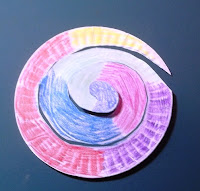As I mentioned in an earlier blog, I enjoy needle felting. I also enjoy tomatoes. Those two subjects seem a bit unrelated,
don’t they? Not if you needle felt
little red tomatoes like I do.
If you want a little red felted tomato, you need to start
with red roving. Now you can make your
tomato entirely of red roving but I like to start with a polyester batting
base. Why have nice red roving hidden in
the center of your tomato where it can’t be seen? I usually try with sculptured items to start
with a plain base or polyester or wool batting.
So gather a bunch of either wool batting or even cheaper
still polyester batting (Yeah like you use in pillows.). I usually start with a ball that is twice the
size of what I imagine the finished item to be.
As you needle felt it, it will shrink down and become firm. Roll it in your hands to start forming the
ball you want. Rolling it in your hand
actually starts bonding the fibers together and then start felting.
 |
| batting |
Keep felting until you get the size and shape you want with
your ball. If you need to add more batting, wrap more around the shape and felt it in.
 |
| batting shape |
Once you have the base the shape you want, now comes the fun
part, adding the color. I started laying
strips of red roving onto the ball base and just felted it in until it was all
covered.
 |
| completely covered |
 |
| adding red roving |
This next step is optional.
Since you have a ball, it is likely to roll around. If you want your tomato to stay in one place,
find an area on the tomato and start felting over and over in that place
(usually about an inch in diameter is a big enough area). The more you felt there, the flatter the area
will be so when you set your tomato down, it won’t roll.
 |
Flattening bottom
|
All tomatoes have a little leaf and stem part that attaches
to the vine. So will this tomato.
Take a small amount of a green roving and place it on your
foam. It doesn’t have to be a lot –
maybe 2” by 2”. Make it a little bigger
than the size you want your leaves to be.
Then place another piece of roving crosswise to the first piece and
start felting.
 |
| leaf roving |
 |
leaf roving 2
|
 |
felted leaf roving
|
Keep felting until all the fibers seem to be bonded and
there are not any thin spots that you can see through. Add more roving if you need to. You want to
have somewhat of a square shape. When
you are ready, cut your leaves. I don’t
use a pattern but you can make one and use.
I take one side of my leaf square and cut out a triangle. I do that on
each side so in the end I have a 4 sided star.
It’s OK if it is a little lopsided.
Not all leaves in nature are perfectly symmetrical.
 |
| cutting roving for leaves |
 |
cutting roving for leaves 2
|
 |
| finished leaves |
Now with your tomato find the area opposite your flat
surface. We are looking for the top and
felt a little indentation. This will help the leaves and stem felt into
the tomato easier. Place the center of
your leaf star over the indentation and felt it in until it is attached. Some of the leaf points may stick out or
up. You can leave them like that (since
that is often what real leaves do) or you can felt them to the tomato. Just give it a couple of pokes at each point
to attach it.
 |
| indentation for leaves |
 |
| Adding leaves |
 |
| attaching tips of leaves |
Now for the stem. I
am one who does not like to waste anything so I usually take a couple of pieces
the cutaway of the felted green from the leaves and start to form them into a
stem. I start with two of the triangles
and roll them together in a rounded rod shape.
Just as you did with the tomato
ball above, roll these pieces between your palms to start the rod shape. Once
you have a good shape, start felting to make the roving look like a stem and also
make it firmer. You wanted it to be a
little bigger at one end so it looks more like a stem.
 |
| finishing stem |
 |
| starting stem |
Once you have it the shape you like, put the bigger end in
the indentation of the leaves and start felting. You might want to put your needle in on an
angle to get through the stem and into the tomato. But remember to pull your needle out the same
way you put it in so it doesn’t bend or break.
 |
| attaching stem |
Once your stem is secure (I usually pick it up by the stem
and shake the tomato. If the stem stays
on, it is secure.), you have a little red (felted) tomato. It is a great summer decoration or a wonderful
gift for a farmer or tomato lover.
 |
| The Little Red Tomato |



























